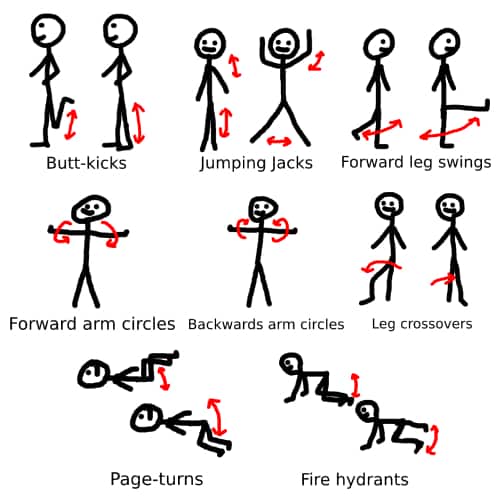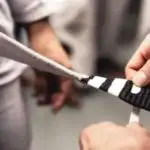Many benefits come with being flexible in Jiu-Jitsu – quicker setups, escapes, rubber guard, etc, etc. You know, that fun stuff! I’ve never been a flexible person, I’ve never been able to touch my toes or lift my (straightened) leg more than a foot off the floor. So, when Jiu-Jitsu was put on hold for a few months I decided to put my efforts into improving my flexibility.
Starting a regular stretching program that targets the legs, hips, back, and neck will be the most beneficial for Jiu-Jitsu. Staying consistent and not rushing the process will ensure your flexibility will improve, injury-free, over time. Over time it will be important to add more stretches to target all parts of your body and target problem areas more appropriately.
Start A Stretching Program
Increasing flexibility successfully will start with selecting a routine targeting the areas in need of improvement. Stretching programs, much like muscle building programs, give you a set plan to increase your flexibility efficiently and safely in a targeted area. A plan will allow you to break down your goals into small, achievable steps.
A good stretching plan will give you a gradual increase in intensity that will allow your muscles, tendons, and ligaments a chance to adjust and acclimatize to the new positions and stretches.
I needed to increase the flexibility in my legs and hips so I started a Splits in 30 Days stretching app. Now, my flexibility was awful before starting the program. I couldn’t touch my toes, I couldn’t kick higher than a few inches above someone’s ankle, or lift my leg while straightened higher than 6 inches.
Keeping my expectations in check I knew I wasn’t going to be able to do the splits in 30 days or come anywhere close to the splits. But I did know it would increase my flexibility in the areas I needed to increase. The program featured 3 modes: beginner, intermediate, and expert. This allowed me to do stretches that were within my comfort zone (albeit they were still hard since I was so inflexible!).
Doing a stretching program helped me focus on my troubled areas. In the past I would do the same leg stretches seeing no progress. A plan allowed me to set aside 15 minutes before bed with pre-determined stretches that would allow me to avoid over/under training my stretches and keep me working towards a goal.
Don’t Stretch Past The Pain
Stretching past the pain or having someone push you further than what your capable of doing can be dangerous and result in injury to the muscle and connective tissues. It’s important to ease into the stretch, relax the body, and breathe.
Moving too far in a stretch and not allowing your body to ease into the stretch the body will trigger a stretch reflex. A stretch reflex is when the muscle surrounding the area being stretched will contract or shorten the muscles you are trying to lengthen. This is your body trying to prevent an injury from occurring. In turn, it causes your range of motion to be shortened which results in less productive stretching.
The optimal way to stretch is to go until you feel some mild tension. When you feel the muscle begin to relax, which could take approximately 30 seconds, slowly ease yourself deeper into the stretch. It is easier to ease deeper into the stretch on your next exhale.
Stretching muscles and tendons that have not been worked on before (or for some time) don’t hold the stretch for too long. When first starting 10-20 seconds may be long enough. Gradually increase the time spent in the stretch to 30-60 seconds.
Doing this will prevent injuries and help ease the newly stretched area safely.
It Takes Time To Become Flexible
It can take 2-4 weeks to feel a difference in flexibility if you’re training regularly and 2-3 months before noticeable improvement. Some people are naturally more flexible and have a higher range of movement in joints, while others have a lifestyle that promotes bad posture, stiffness in shoulders, tight hips and legs, and sore necks.
Desk jobs and standing jobs are the worst for developing a stiff inflexible body. Sitting at a desk usually comes with bad posture, poor hip position, shoulders rolled forward – causing a tight back – and legs bent reducing your hamstring flexibility over time.
Flexibility takes time to achieve especially if you have gone years without regular stretching habits. However, incorporating even 10 minutes a day to stretching can greatly improve flexibility over time.
Always make sure to warm up before performing stretches. Like working out muscles with resistances, stretching requires your body to be warm, otherwise, you risk injury. Dynamic stretches are a great way to warm up your body while also providing a method to stretch your body.
It’s important not to rush the process as overstretching and injury can occur.
Simple Stretching Routine To Improve Your Jiu-Jitsu
| Warm-up: 30 seconds each | Stretches: 30-60 seconds each |
| Butt-kicks | Standing, wide-leg floor touch |
| Jumping jacks | Sitting, pulse toe touch |
| Forward leg swings | Lunge stretch (left and right) |
| Forward arm circles | Seated butterfly |
| Backward arm circles | Cat/Cow |
| Leg crossovers | Thread the needle |
| Page-turns | Cobra |
| Fire hydrants | Child’s pose |
| Downward dog | |
| Cross arm stretch | |
| Triceps stretch | |
| Side head tilt/Ear to shoulder |
Warm-ups

Stretches

Conclusion
The best way to improve flexibility for Jiu-Jitsu is to target stiff areas on your body and start a regular stretching routine targeting those problem areas. The hips, hamstrings, and neck are important parts of your body to work on if you’re strapped for time as they are always used in Jiu-Jitsu.
Staying flexible will allow give you better body dexterity allowing you to escape, move into positions, and set up submission quicker and precisely. Flexibility also provides additional techniques and positions that are near impossible without it.
If you want to learn more about the benefits of flexibility checkout my article: The Benefits Of Flexibility In Jiu-Jitsu.


